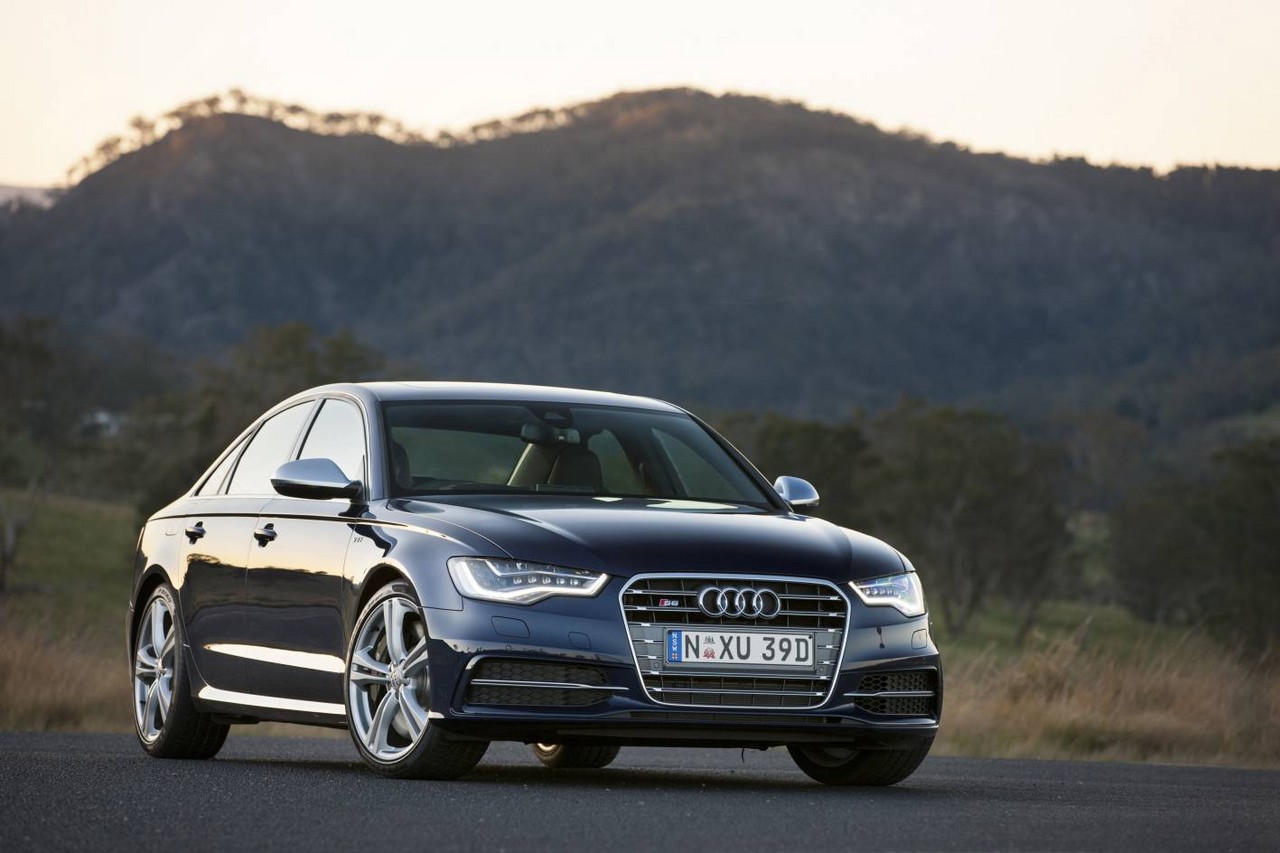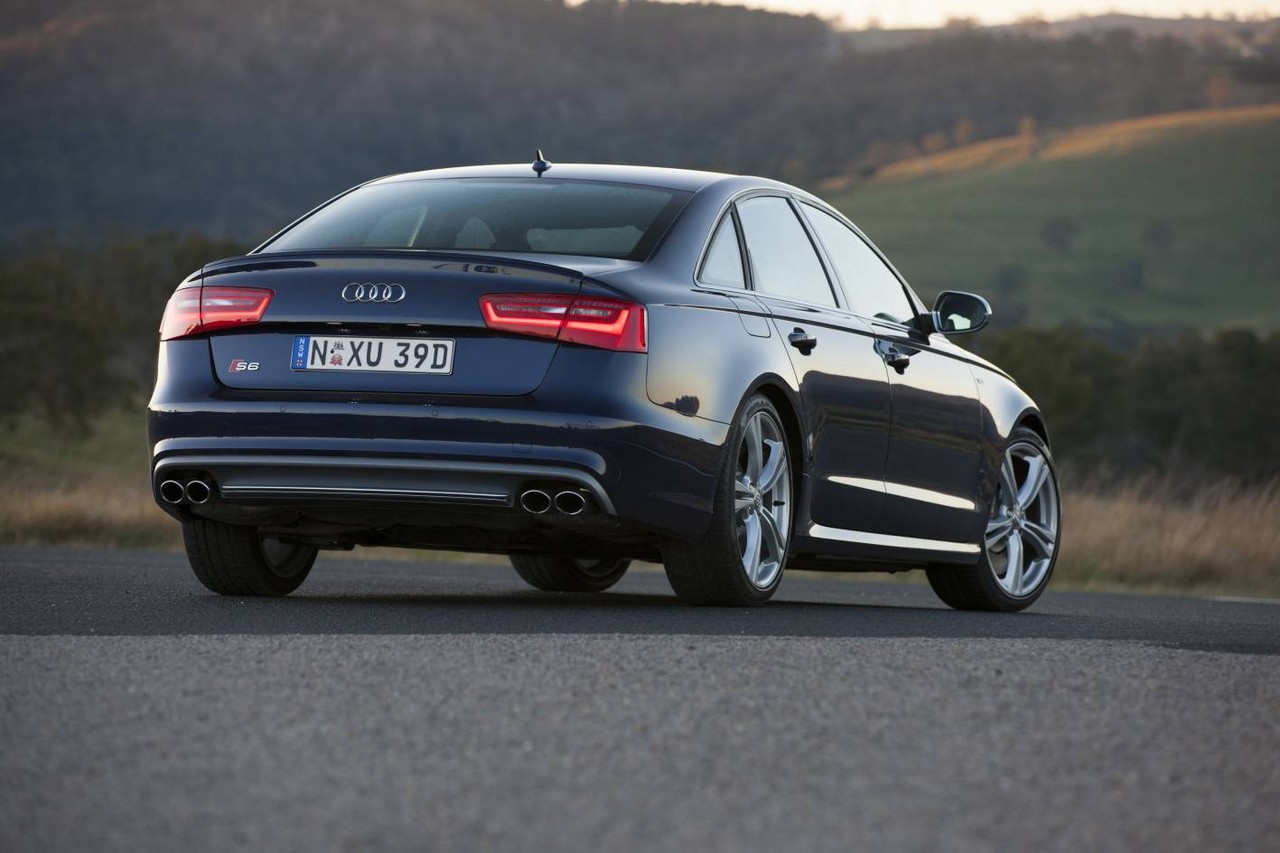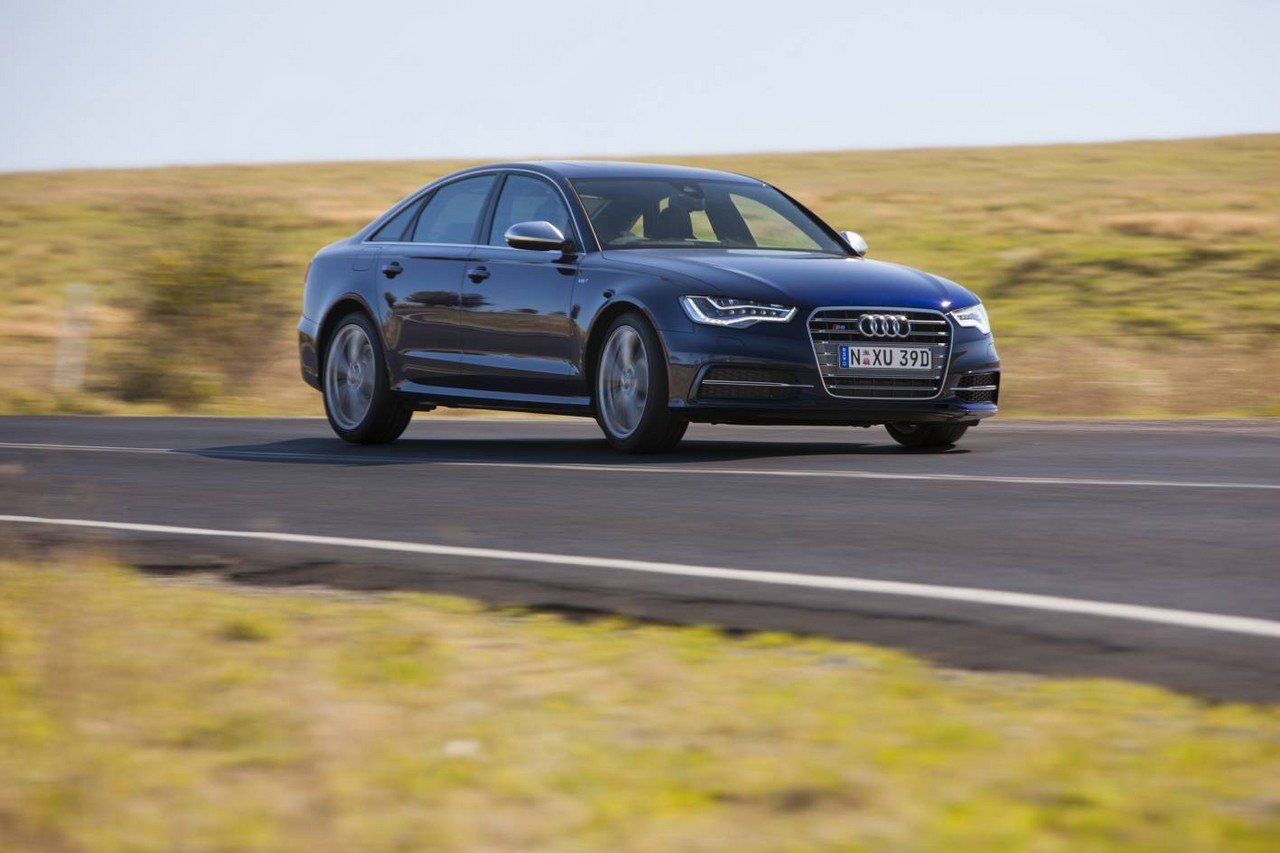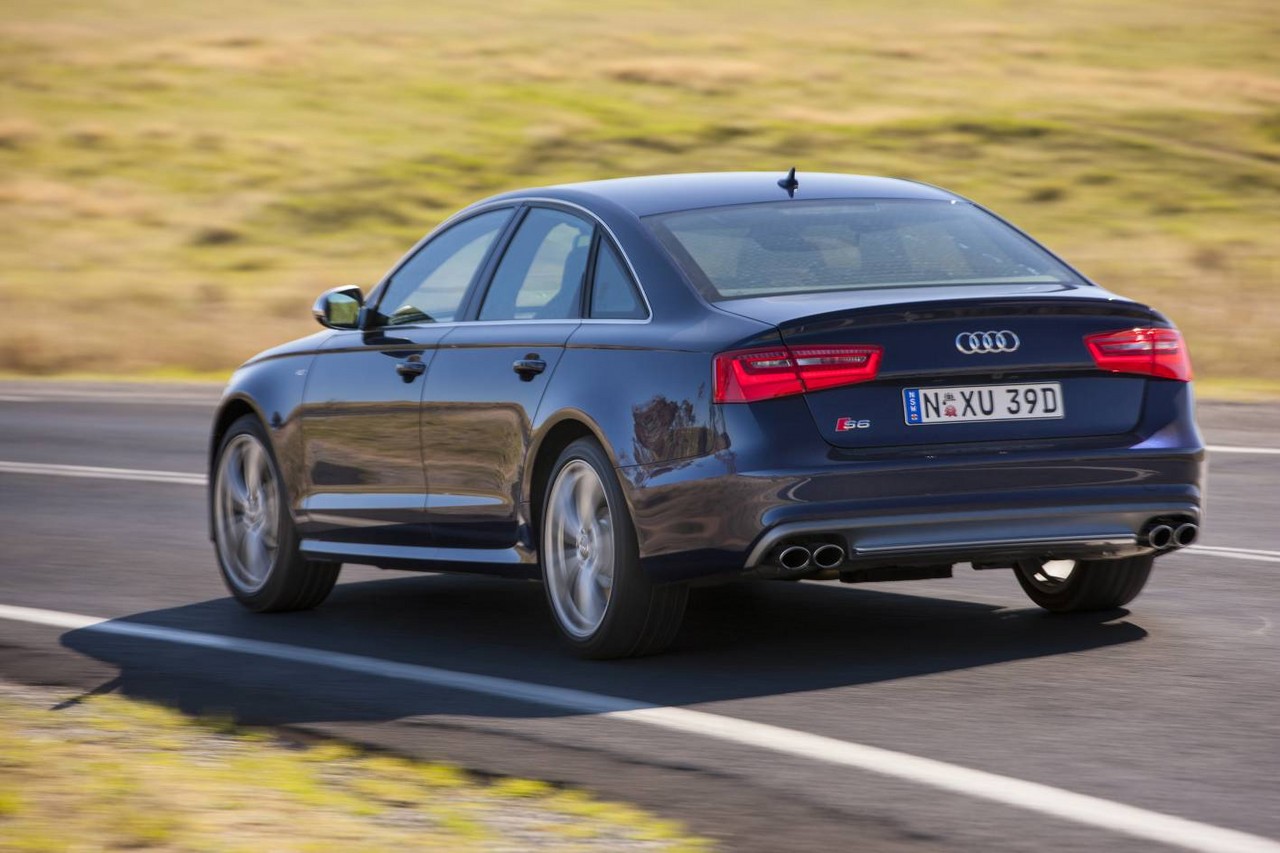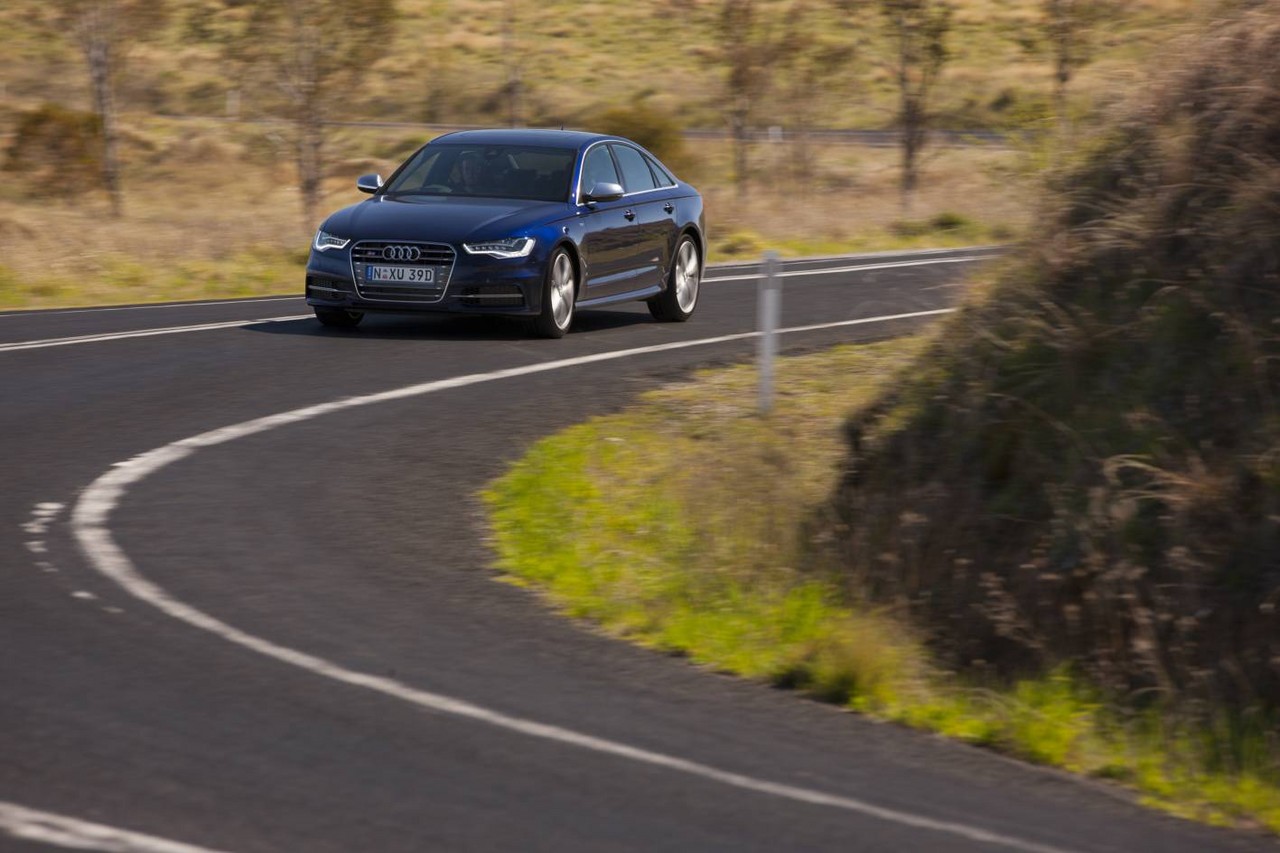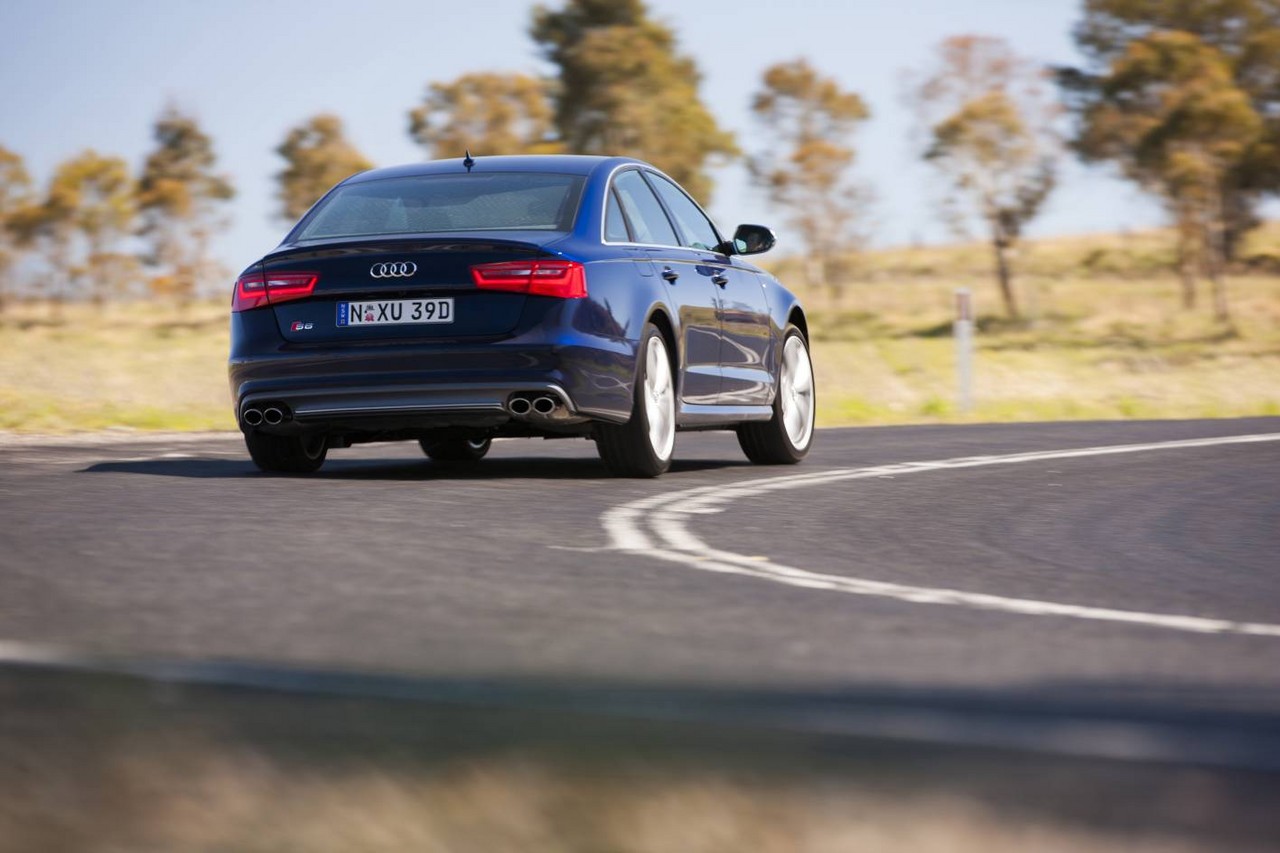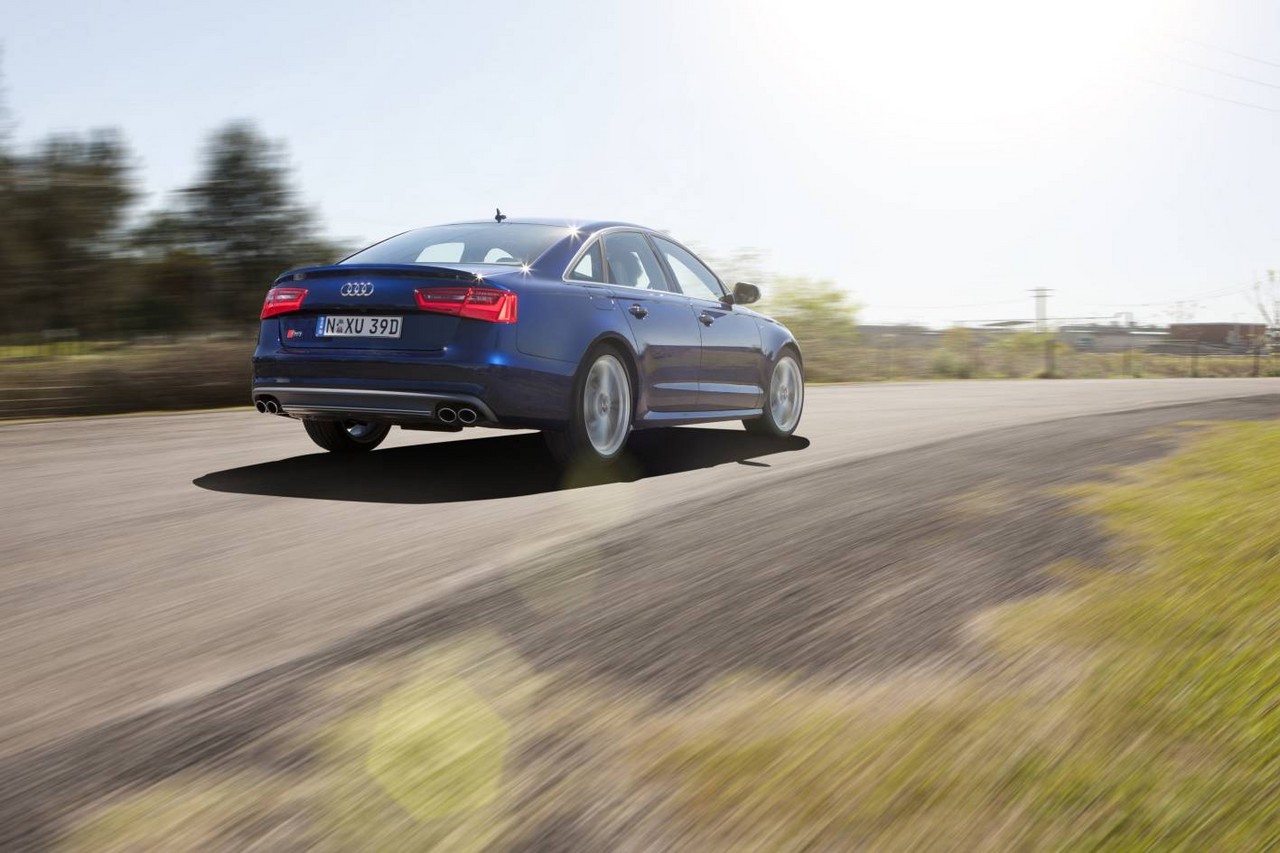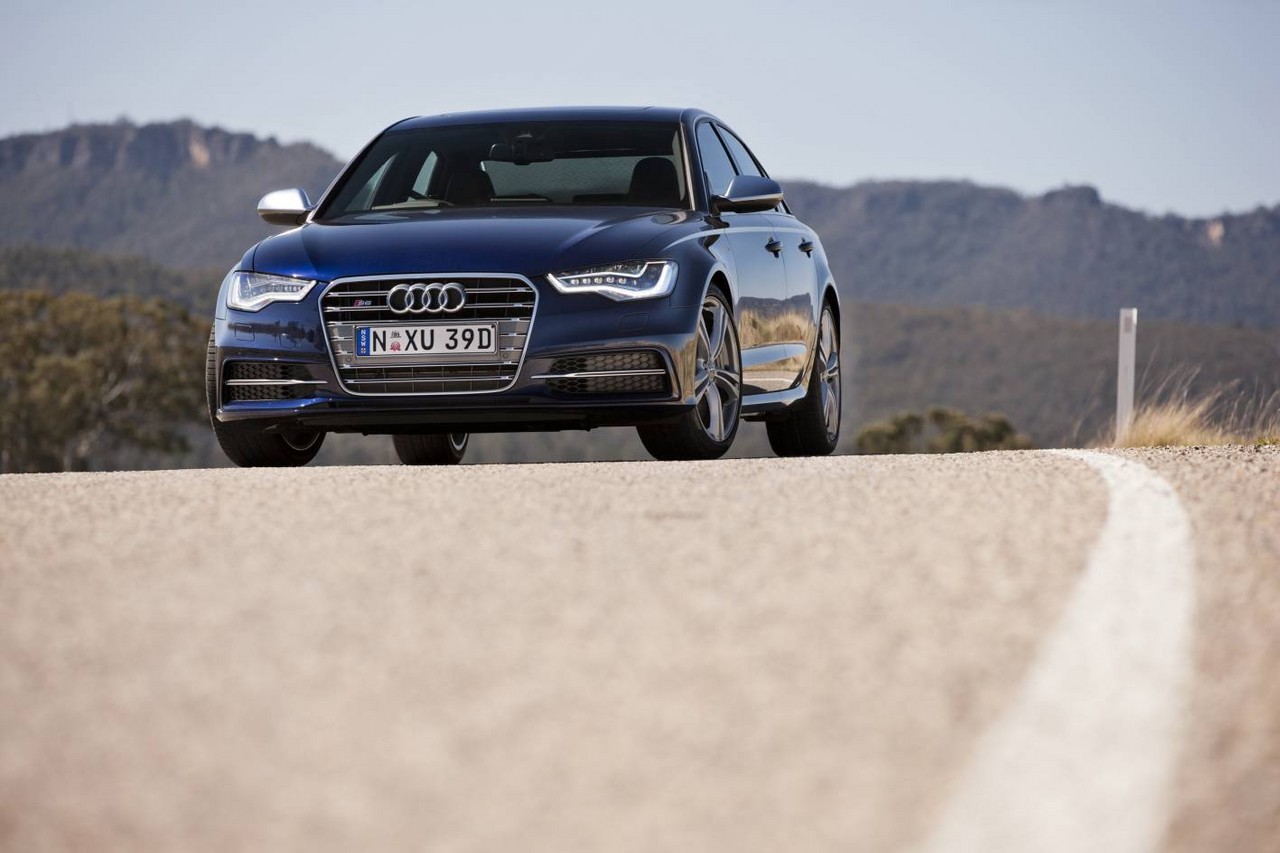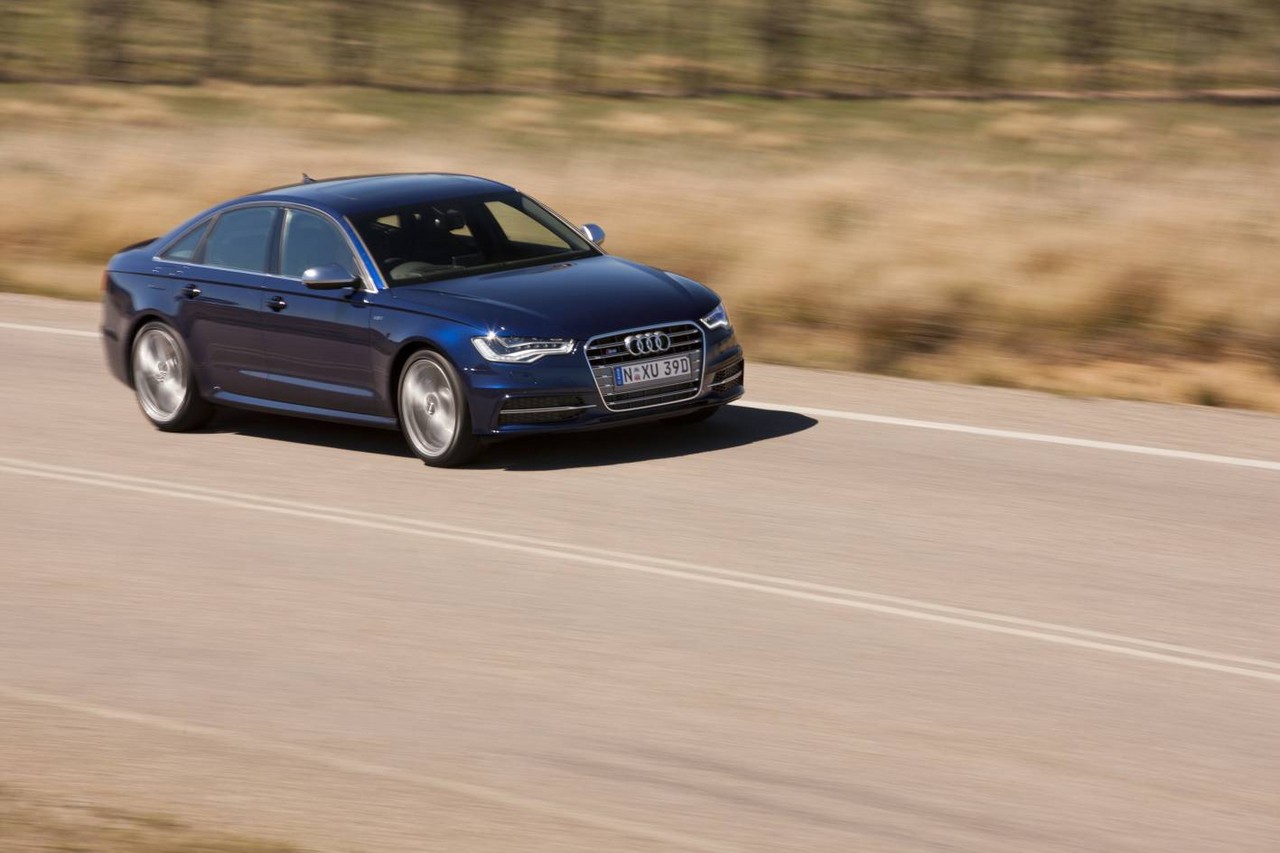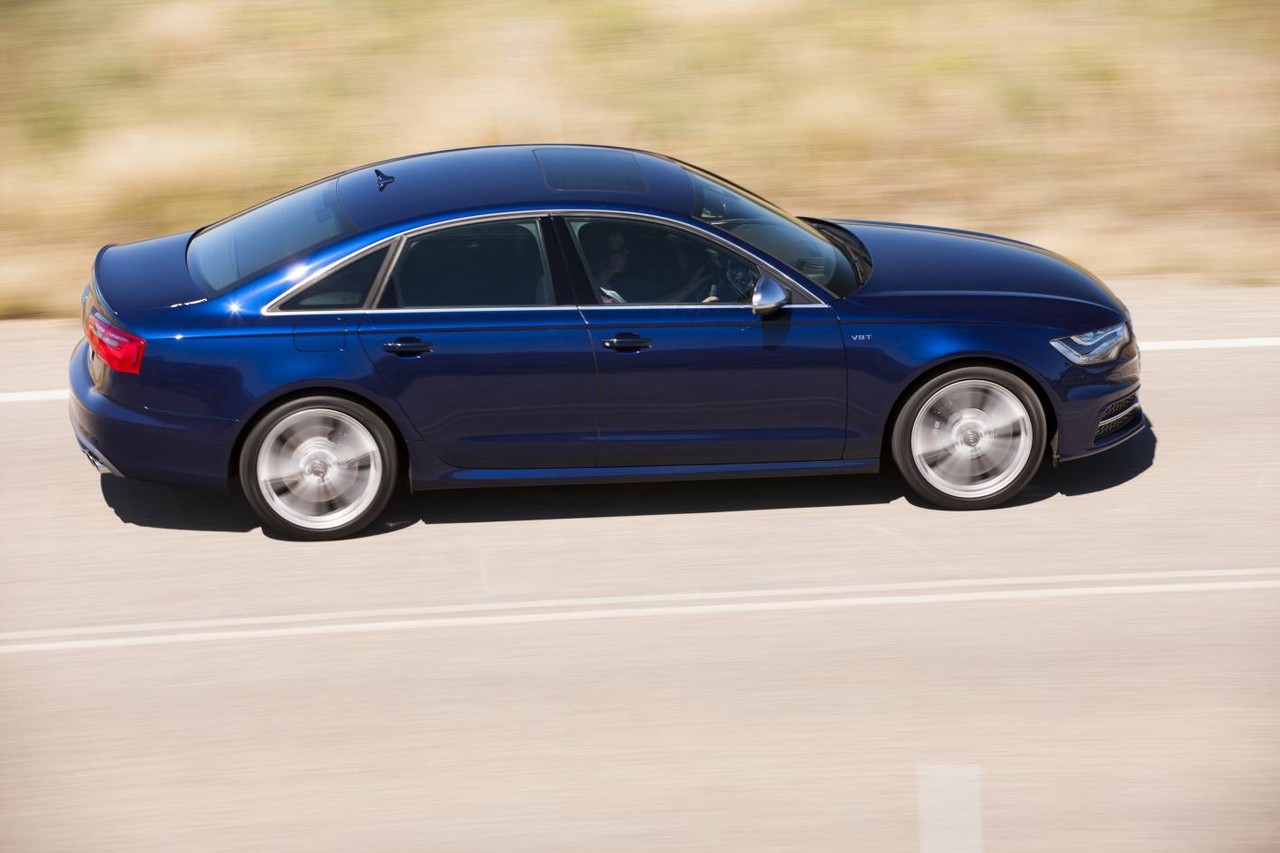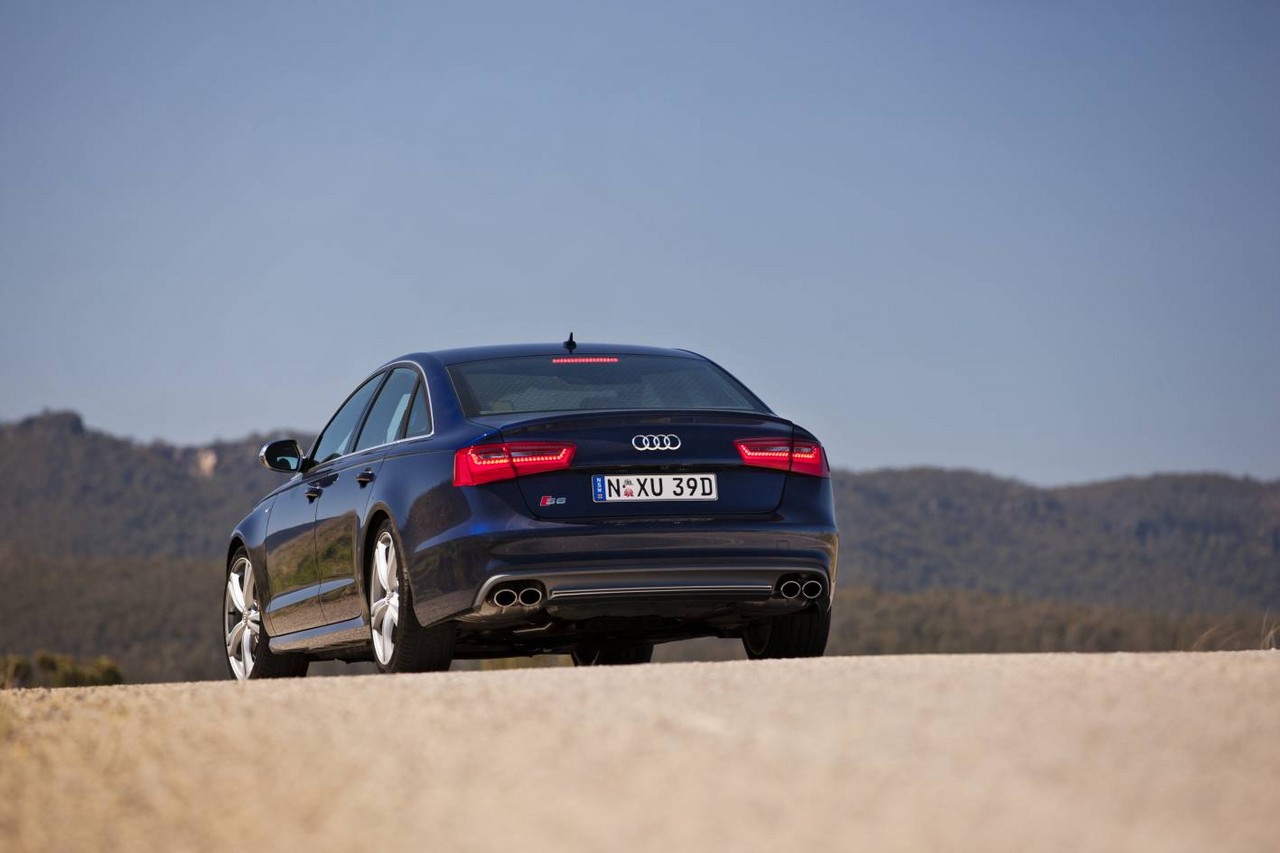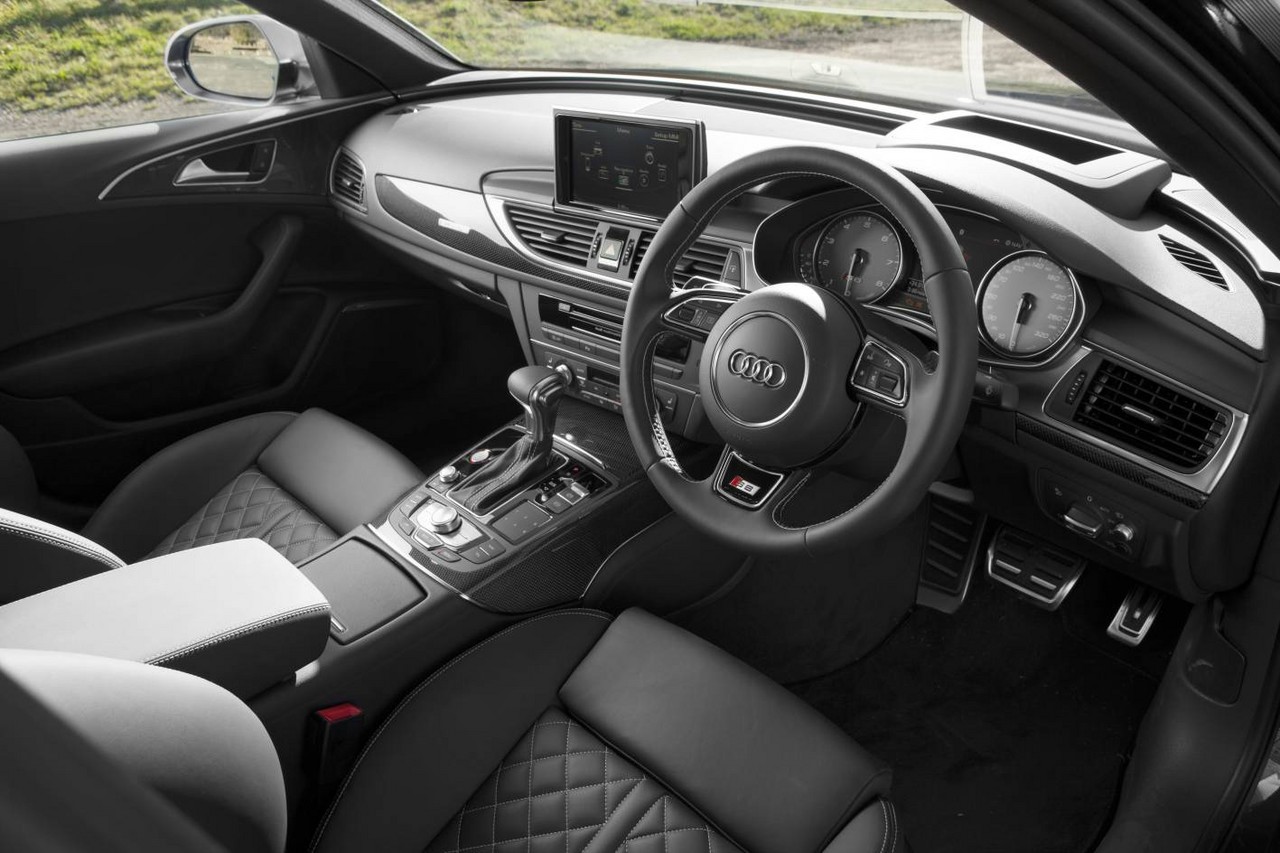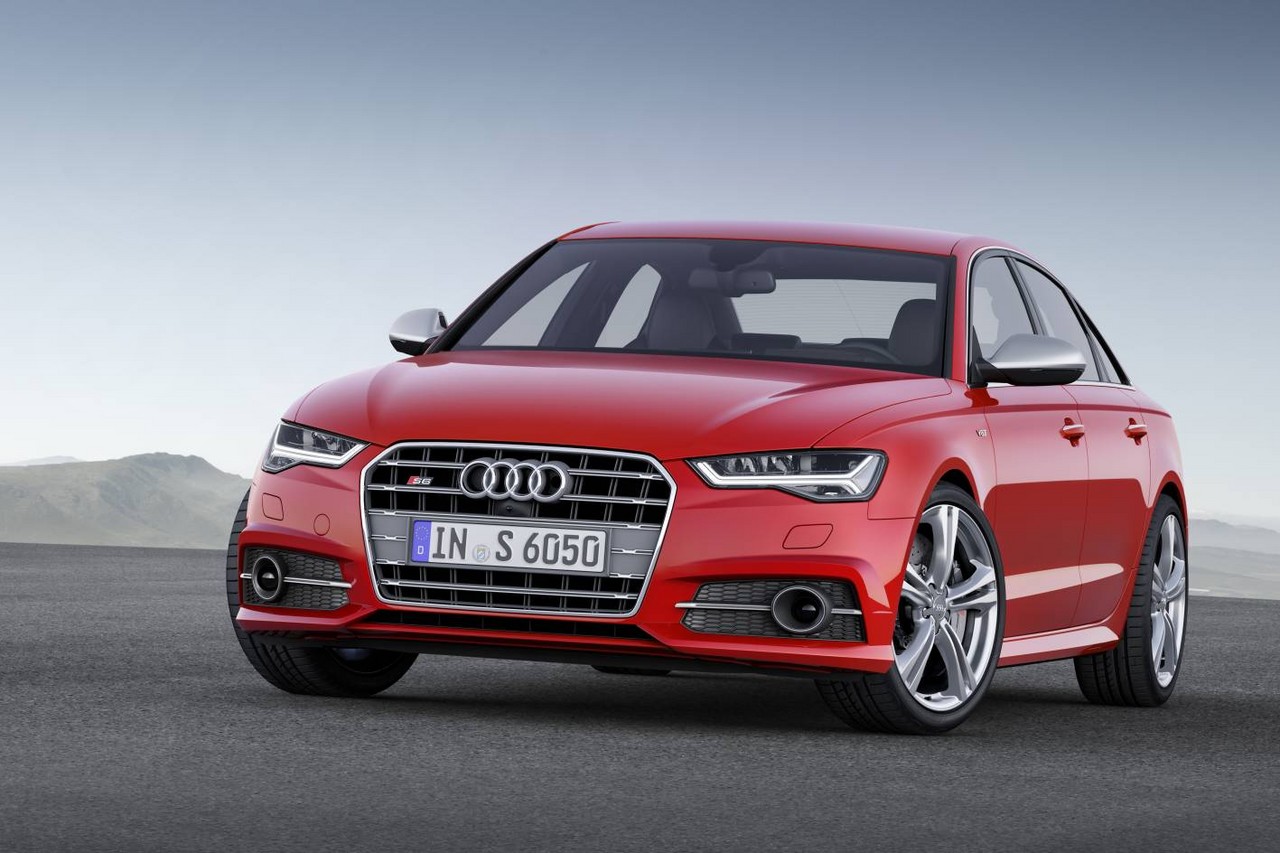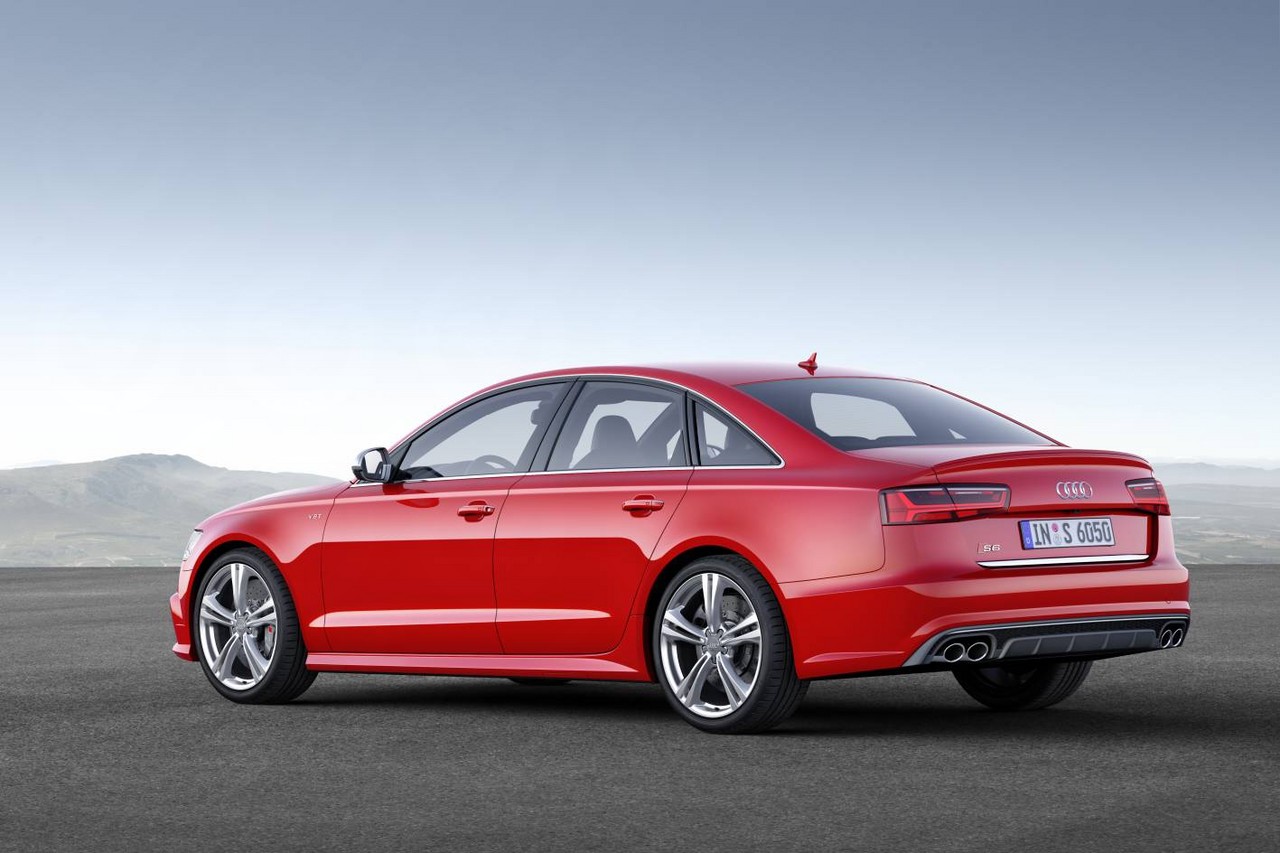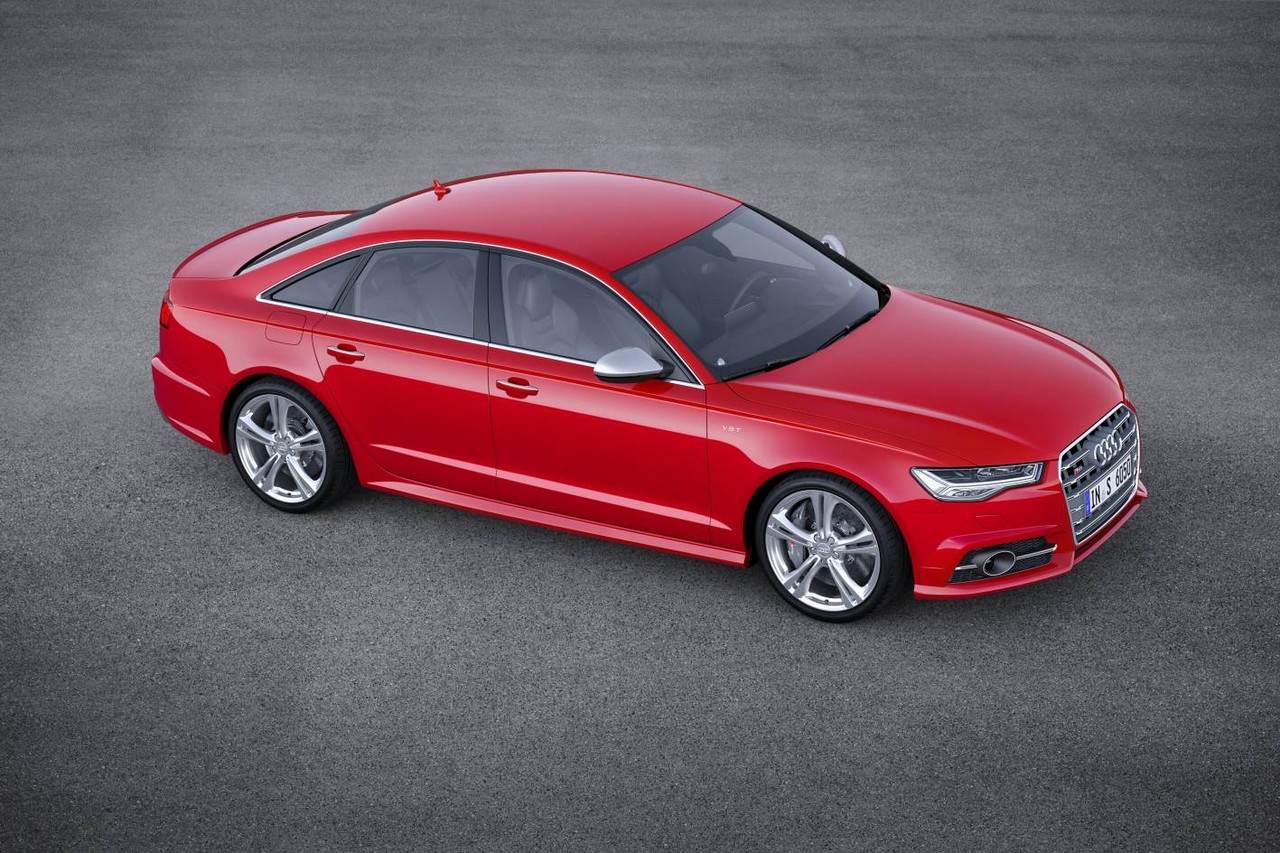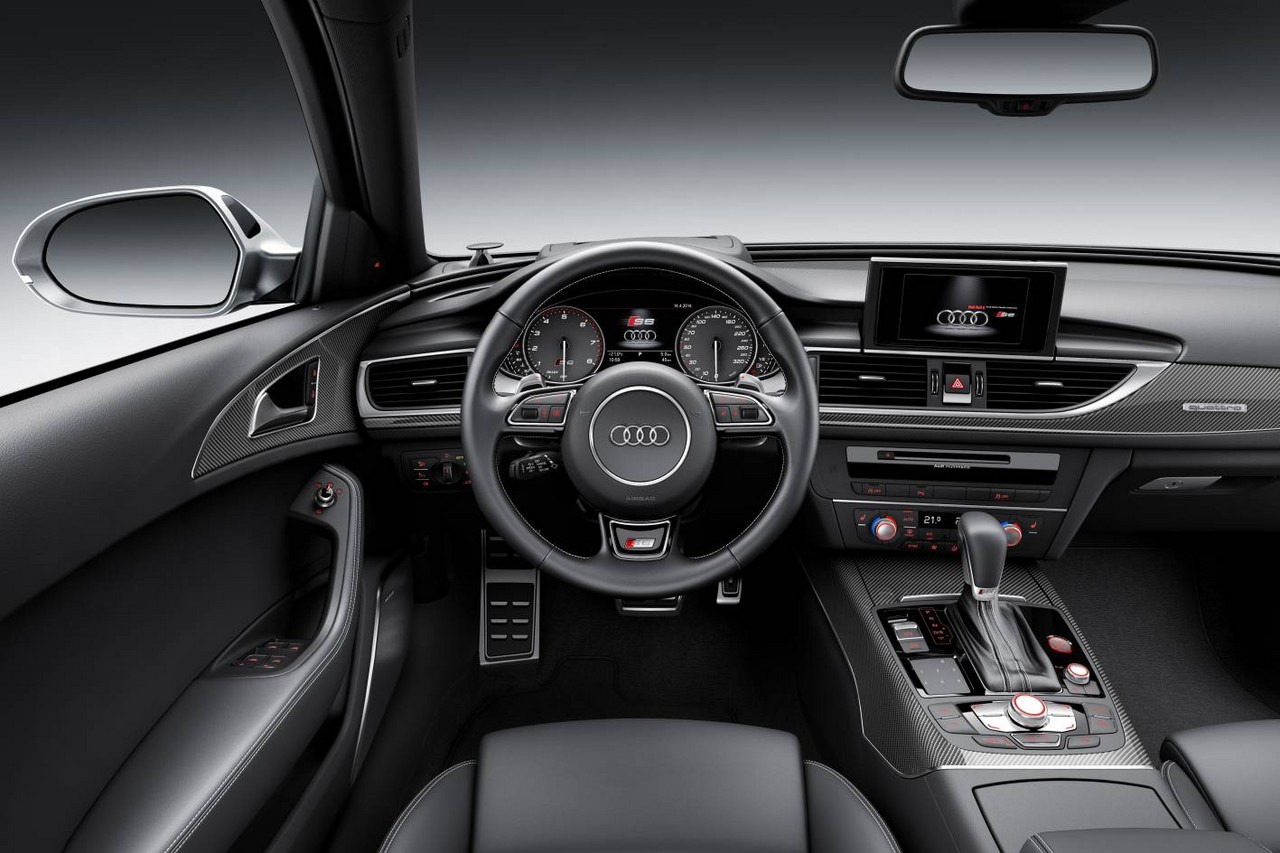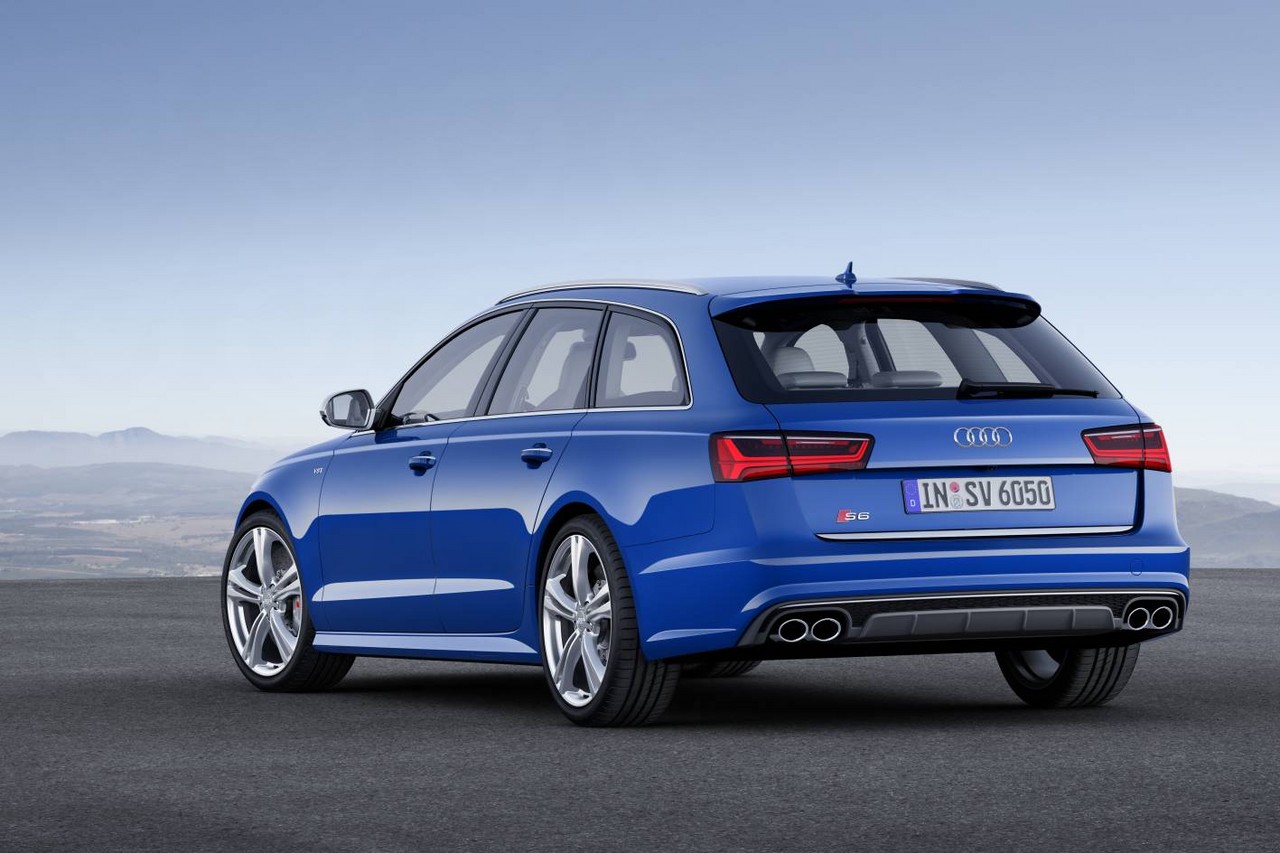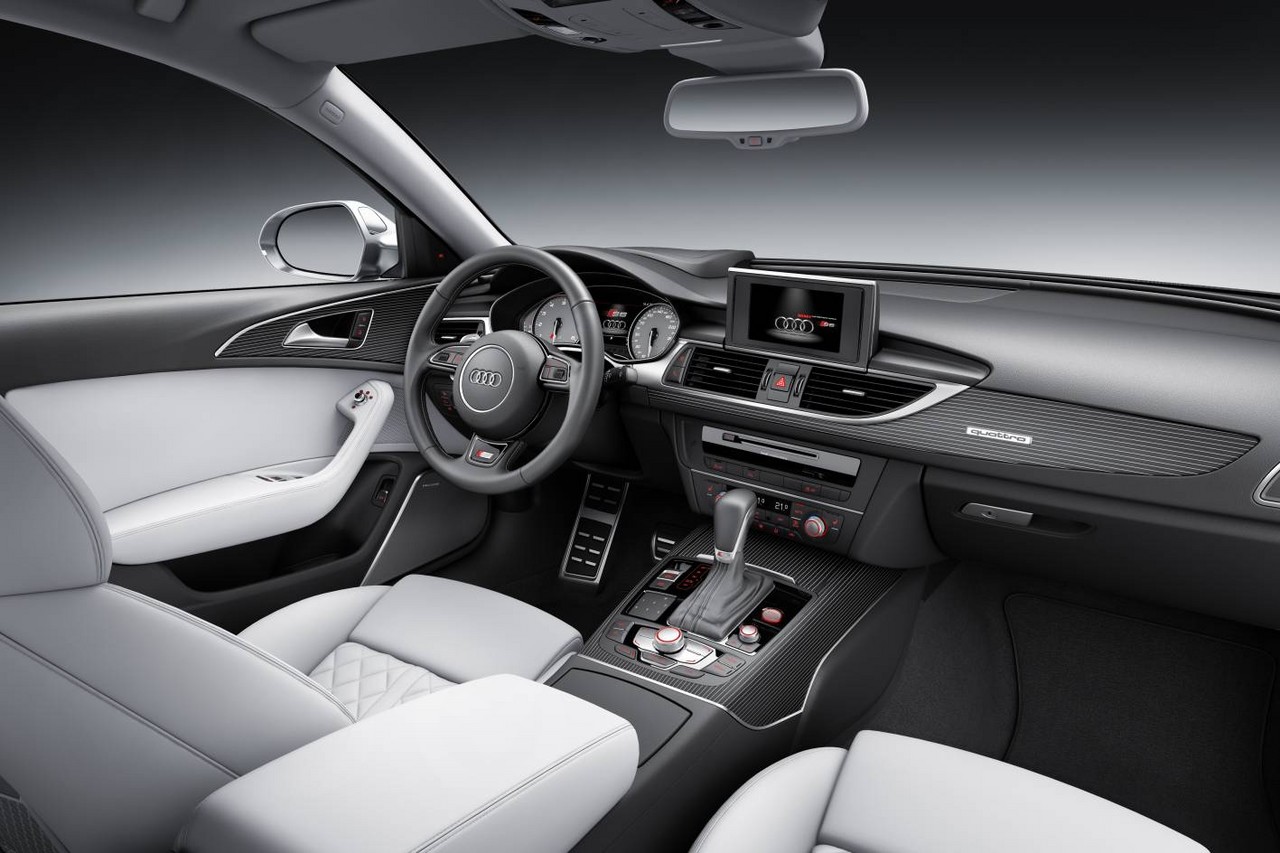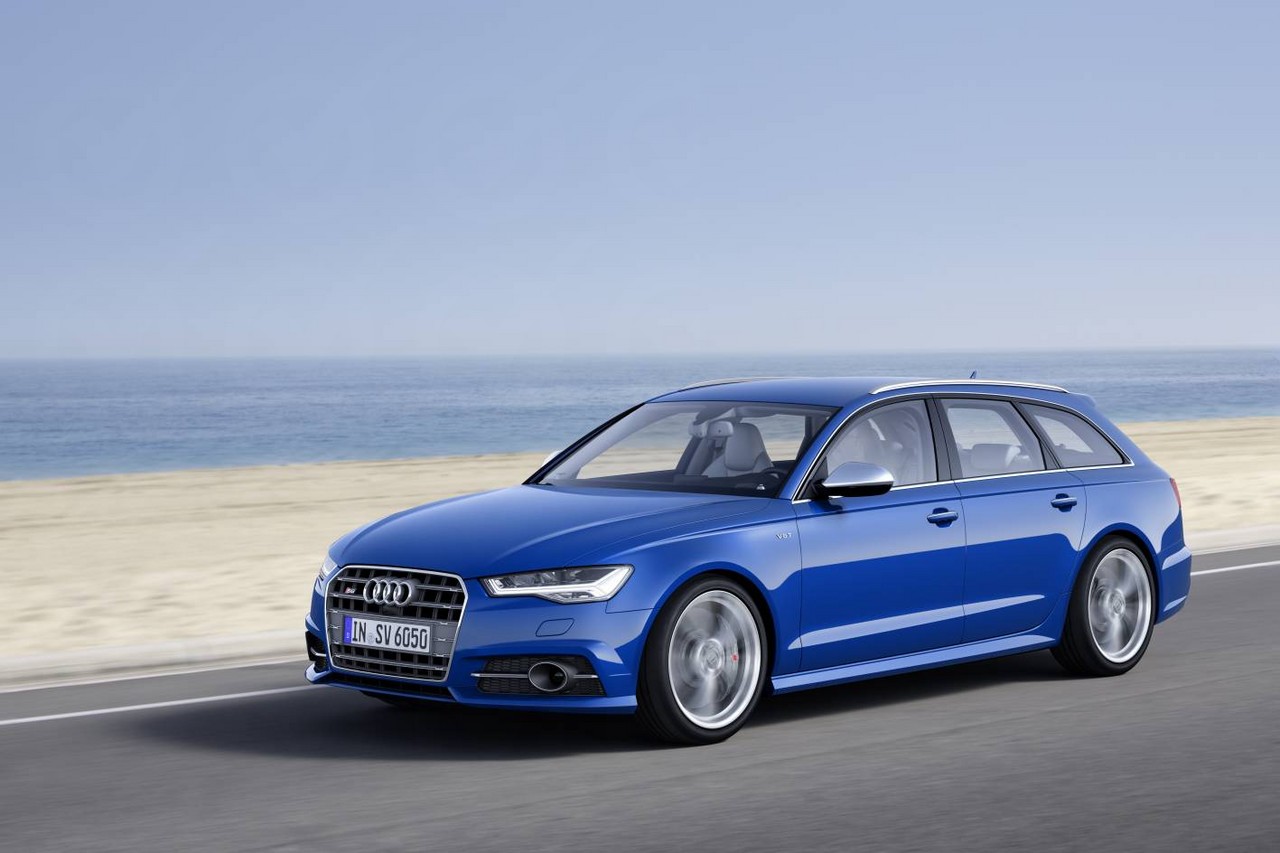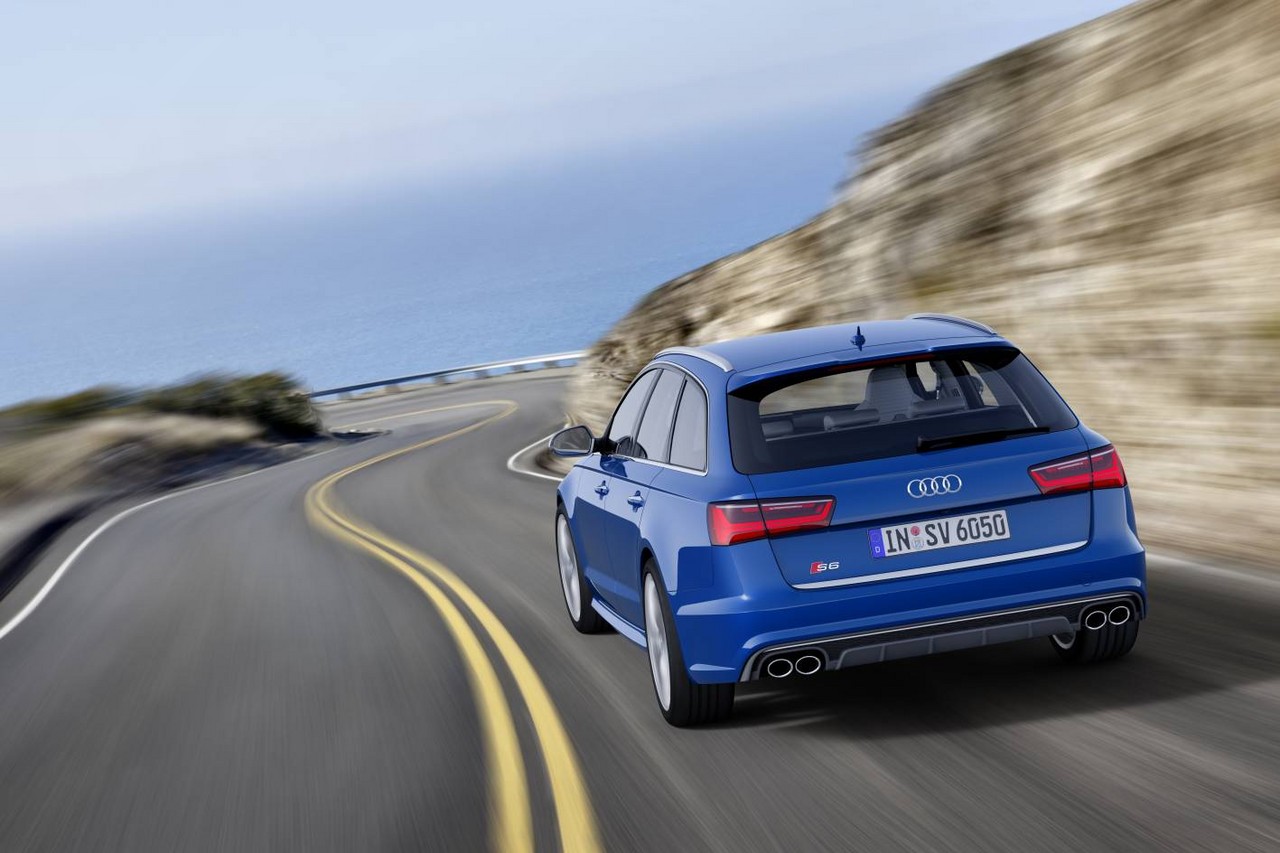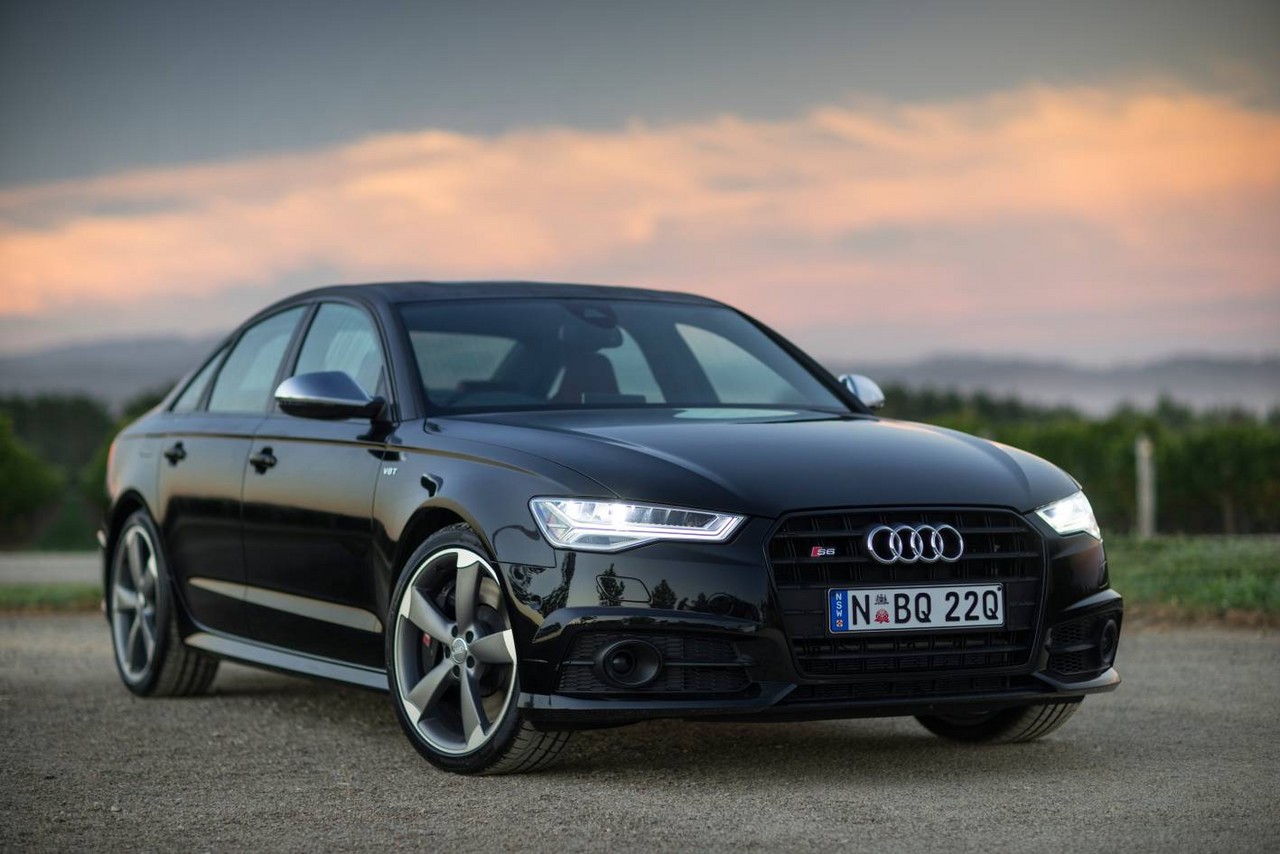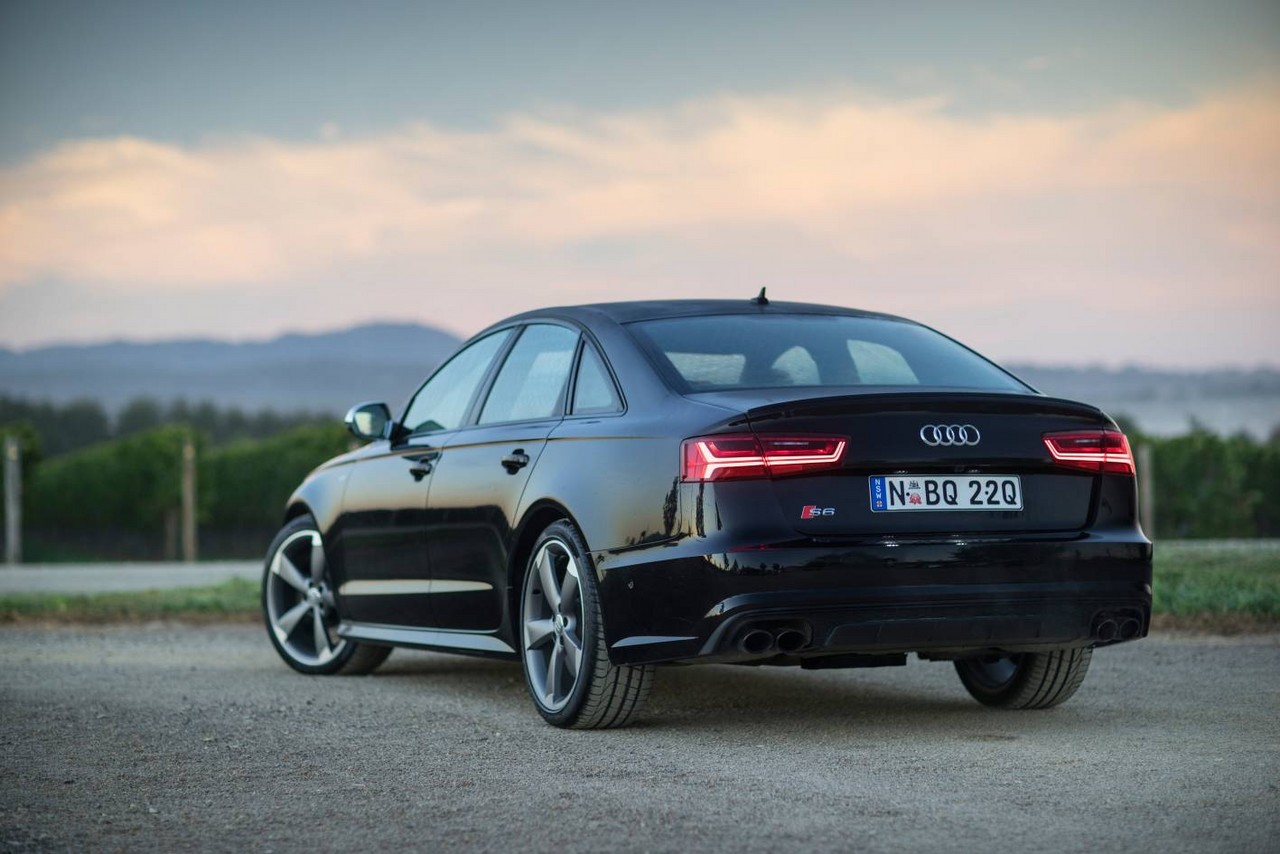
- Powerful 4.0-litre twin-turbo V8 engine
- quattro system provides immense traction and stability
- High standard of interior fit and finish
- With 20-inch alloy wheels, suspension lacks compliance
- Inconsistently weighted steering lacks self-centring action
- Weight blunts agility
- Spongy brake pedal
Review: Audi C7.I S6 (2012-14)
Overview
Released in October 2012, the Audi C7 Series I (C7.I) S6 was a high-performance executive sedan. Manufactured in Neckarsulm, Germany, the Audi C7 S6 was powered by a 4.0-litre twin-turbo V8 petrol engine that was mated to a seven-speed double clutch transmission (Audi’s ‘S-Tronic’) and drove all four wheels via Audi’s quattro system. The C7 S6 could accelerate from rest to 100 km/h in 4.8 seconds.
4.0 TFSI V8 engine
Based on the V10 engine from the Audi C6 RS6 , the 4.0-litre twin-turbo CEUC V8 petrol engine had direct injection (Audi’s ‘Fuel Stratified Injection’ or FSI), double overhead camshafts per cylinder bank, continuously variable valve timing for the intake and exhaust camshafts, four valves per cylinder and a compression ratio of 10.1:1. Furthermore, the two twin-scroll turbochargers and had twin air- and water-cooled intercoolers. The engine also featured:
- A ‘cylinder on demand’ cylinder management system which could deactivate four cylinders under part load throttle applications. When in operation, an Active Noise Cancellation (ANC) system would be activated and use four microphones – integrated into the vehicle’s headlining – to produce anti-phase sounds through the vehicle’s sound system;
- An ‘idle stop’ system which enabled the engine to shut down when the vehicle was stationary;
- A brake energy regeneration system which converted the vehicle’s kinetic energy – when braking or coasting – to recharge the battery; and,
- Engine noise minimisation devices included electronically-controlled bearings, a sound actuator, flaps in the exhaust system and a newly developed two-mass flywheel with a centrifugal force pendulum in the transmission.
| Engine | Trans. | Peak power | Peak torque | |
|---|---|---|---|---|
| S6 | 4.0-litre CEUC twin-turbo petrol V8 | 7sp DCT | 309 kW at 5500-6400 rpm | 550 Nm at 1400-5200 rpm |
Dimensions and suspension
Compared to the Audi C6 S6 , the C7 S6 was 15 mm longer (at 4931 mm), 20 mm wider (1875 mm), 19 mm taller (1468 mm) and had a 69 mm longer wheelbase (2912 mm); the C7 also had a S6 kerb weight of 1895 kg.
The Audi C7 S6 had five-link front suspension and self-tracking trapezoidal link rear suspension. For the S6, the adaptive air suspension with variable damping was also fitted as standard, enabling the body to be lowered by 20 mm from its standard position.
quattro
The C7 S6’s quattro four-wheel drive system utilised an Audi-developed ‘Crown Gear’ centre differential. In normal conditions, the system provided a 40:60 front:rear torque split. If traction was lost, however, up to 80 per cent of the engine’s torque could be directed to the rear axle, and up to 70 per cent to the front axle.
The quattro system included open front and rear differentials with electronic differential locks which could brake spinning wheels to enable cross-axle torque transfers. The latter function could be activated pre-emptively by a torque vectoring feature which braked the vehicle’s inside wheels when cornering to reduce understeer.
Safety equipment
Standard safety equipment for the Audi C7 S6 included dual front airbags, front and rear side airbags, full-length curtain airbags (i.e. for front and rear occupants), ABS, electronic brake force distribution, brake assist, electronic stability control, traction control and front seatbelts with pretensioners and load limiters.
Euro NCAP testing
In Euro NCAP testing , the related Audi C7 A6 sedan received a five star safety rating with a 91 per cent adult occupant protection rating and an 83 per cent child occupant protection rating. In the offset crash test, there was a slight risk of serious chest and leg injury for the driver. In the side impact test, one point was deducted because the driver door unlatched. Under ANCAP’s methodology , this testing resulted in an adult occupant protection rating of 34.91 out of 37.
Features
Standard features for the Audi C7 S6 included 20-inch alloy wheels with 255/35 R20 tyres, a 600 watt Bose sound system with fourteen speakers, a CD player, MP3/WMA-compatibility and auxiliary inputs, Multi Media Interface (Audi’s ‘MMI’) with an eight-inch colour touch screen, hard-drive navigation and a digital TV tuner, four-zone climate control air conditioning, power adjustable and heated front seats, combination Alcantara/leather sports seats, cruise control, Bluetooth connectivity, head-up display, LED headlights with high beam assist, front and rear parking sensors, a reversing camera, automatic headlights, rain-sensing wipers, a leather-wrapped sports steering wheel with gearshift paddles, split and folding rear seats, remote central locking with proximity key, power windows and heated mirrors, cargo net, driver memory settings (seats and mirrors), tyre pressure monitoring, an electromechanical parking brake, driver memory settings (seat and door mirrors), ambient lighting, a power-operated glass sunroof, 12 volt power outlet, trip computer, an alarm and immobiliser.
Related links
Review: Audi C7.II S6 (2015-18)
Overview
Released in Australia in March 2015, the Audi C7 Series II (C7.II) S6 could be identified by its revised headlights, single frame grille, air inlets, bumpers, side sills, rear lights and tailpipes. With its more powerful engine, the C7.II S6 could accelerate from rest to 100 km/h in 4.4 seconds.
| Engine | Trans. | Peak power | Peak torque | |
|---|---|---|---|---|
| S6 | 4.0-litre CTGE twin-turbo petrol V8 | 7sp DCT | 331 kW at 5800-6400 rpm | 550 Nm at 1400-5700 rpm |
Safety equipment
For the Audi C7.II S6, standard safety equipment was extended to include:
- Adaptive cruise control (ACC): radar-based cruise control which maintained a preset distance from the car ahead. For the S6, ACC included a ‘stop & go’ function for low speeds which could bring the vehicle to a stop and accelerate from rest;
- Audi pre-sense front: in the event of a pending front-to-rear collision with the vehicle ahead, the driver would be progressively is warned and brakes could be applied autonomously (‘Autonomous Emergency Braking’). At speeds below 30 km/h, nearly full braking force would be applied;
- Audi side assist: used two radar sensors to monitor the area 70 metres behind the vehicle during lane change manoeuvres at speeds over 30 km/h. If there was a vehicle in the driver’s blind spot or an approaching vehicle was detected, the driver would be alerted by a warning LED in the respective door mirror. If the driver activated the turn signal, the LED would flash several times at high frequency;
- Audi pre sense rear: if a rear-end collision was anticipated, the seats would be moved into the safest position for a collision; and,
- Audi active lane assist: operating at speeds in excess of 65 km/h, a video camera could detect lane markings. If the vehicle approached a lane marking without indicating, the steering system would make automatic adjustments to keep the vehicle in its lane. The steering wheel could also be set to vibrate to warn the driver.
Features
Standard features for the Audi C7.II S6 were extended to include Audi’s new MMI navigation plus system with MMI touch (including live traffic updates, MMI radio, a CD/DVD player, SD card readers, Audi Music Interface and 10GB flash memory), digital radio reception, a power adjustable steering column (with memory settings) and power folding door mirrors.
Related links
- Specifications: Audi C7.II S6 (March 2015)
- Technical Data: Audi C7.II S6 (March 2015)
- Press Kit: Audi C7.II A6 and S6 (March 2015)
- Audi Australia: Audi S6
- Wikipedia.org: Audi C7 S6
